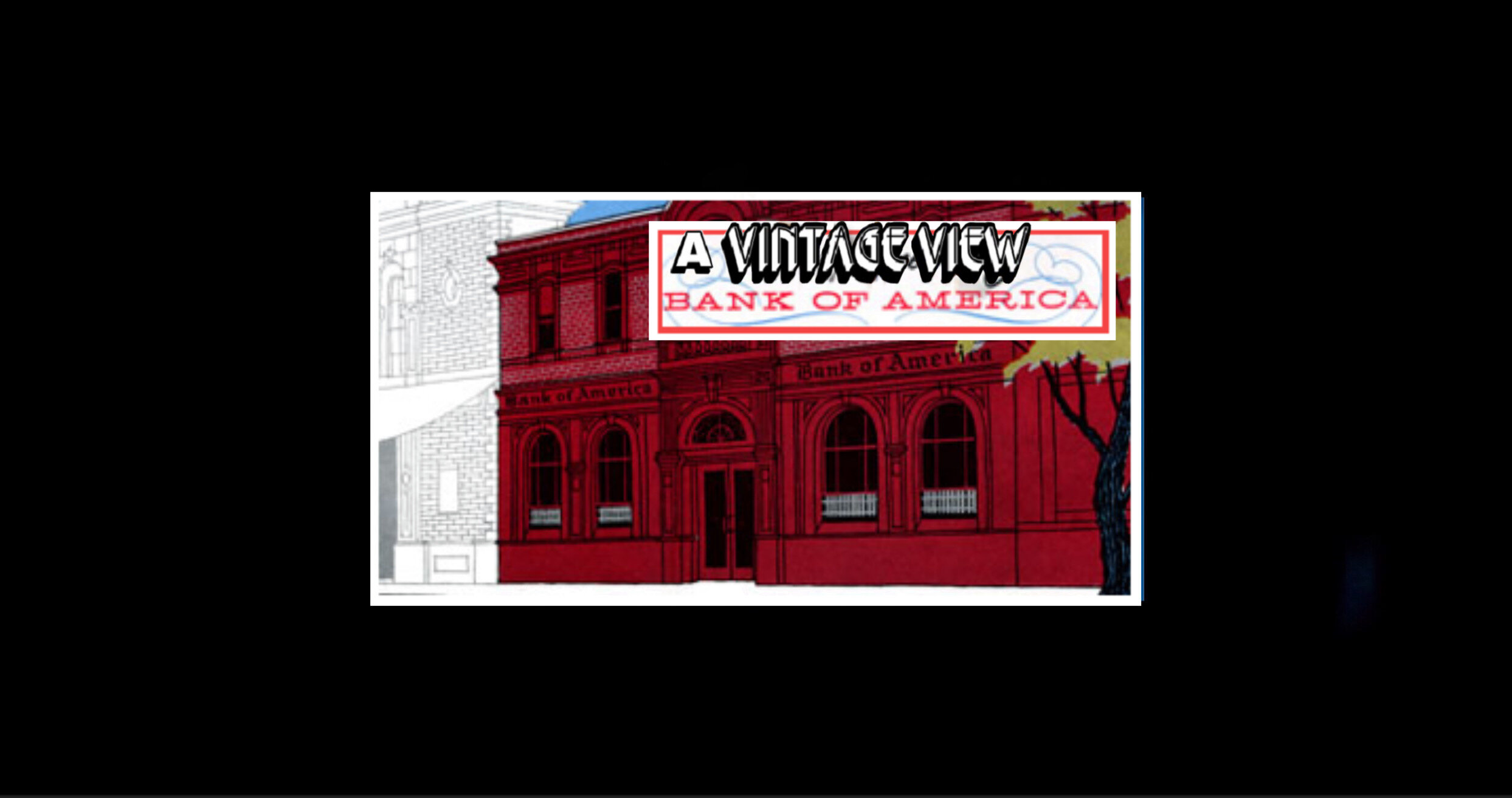BANK OF AMERICA (and UNION BANK)
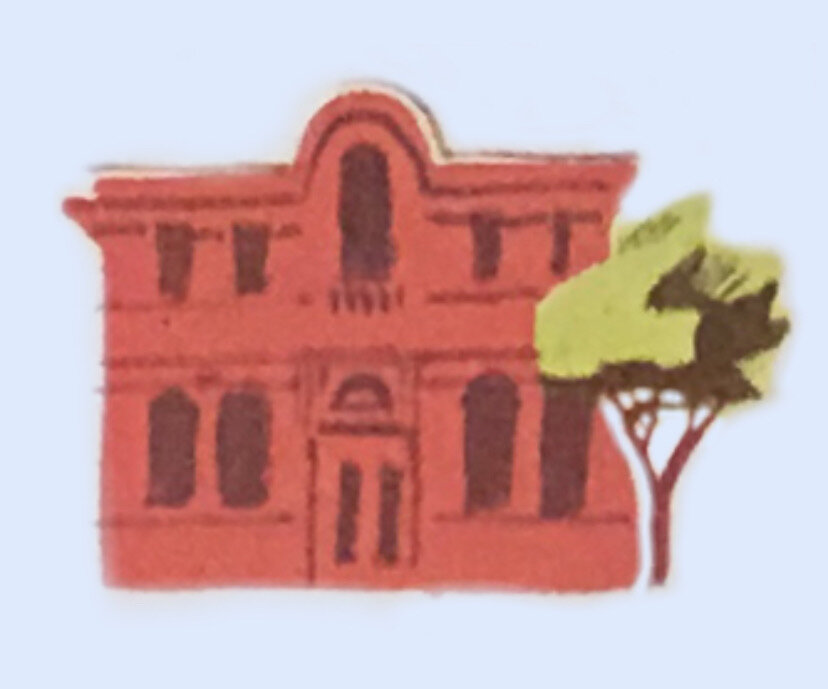

(July 17, 1955 - 1993)
“The Walt Disney (and Bank of America) Story”
The story of Walt Disney and Bank of America dates back to the 1930s. “Bank of America helped launch… [the] fledgling industry called ‘movies.’ It backed such luminaries as Charlie Chaplin, Cecil B. DeMille, Douglas Fairbanks, Samuel Goldwyn and Frank Capra. It financed hundreds of films including classics like West Side Story, Lawrence of Arabia, and It’s a Wonderful Life. It provided critical funding to finish Gone With the Wind. When Walt Disney couldn’t get money to complete his dream - to make the first full-length animated film - Bank of America stepped in. Walt was able to finish Snow White and the Seven Dwarfs and it became an instant success. The bank financed many other later films - fantasia, Pinocchio, Peter Pan, Cinderella, Bambi,” according to “Bank of America - A Heritage of Service,” (published c. 1997).
For now, to meet Walt Disney Productions stepped up production program, arrangements were completed for a line of bank credit through December 31, 1955, with the Bank of America, Los Angeles, and the Bankers Trust Company New York.
“Blue Sky and Development”
Similar to Walt Disney’s Productions shown on the “silver screen,” Disneyland® Park was just another stage and theater concept. The presentation of the Bank of America show on the vast DISNEYLAND “stage” was a distinct part of the Disneyland theater concept. Since Disneyland’s earliest stages of development, the model for the Park has included a bank.
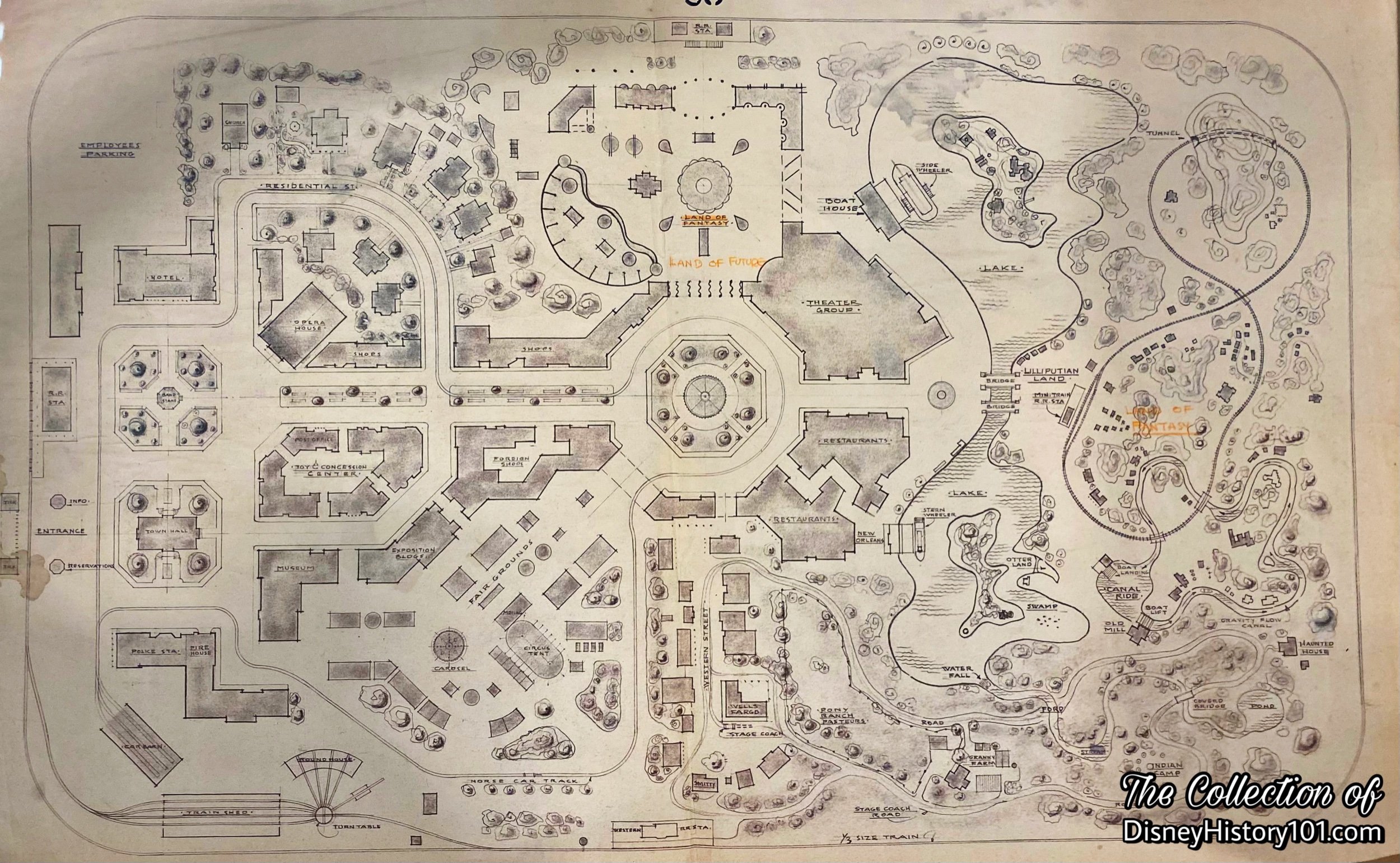
“Initial Concepts by Disneyland, Inc.”
The earliest plot plans (as the schematic pictured above) included a bank. Herb Ryman completed the iconic “Aerial Over Disneyland” concept drawing (depicting a bank building), originally produced over the weekend of September 26 & 27, 1953. A year later, “The Disneyland Story” (produced on September 3, 1954), told the story of what guests would experience once entering Disneyland. The opening page states : “You find yourself in a Civic Center or Town Square at the turn-of-the-century, any time from 1890 to 1910. Here you will see…the Bank.”
“Bank of America Invests in Walt Disney’s Disneyland”
During 1954, Walt was searching for Participants to lease shop and restaurant spaces at Disneyland, and help generate the necessary capital to fund construction of Disneyland. In a synergistic relationship, the companies (in turn) could sell their products and advertise their corporate names in the Park. Disneyland Participant Corporate Sponsors were carefully selected. High quality, long term corporate sponsors would provide incremental income that enabled Disneyland to enhance its show and attractions, offset some operating expenses, and capitalize on marketing opportunities.
By July 1, 1954, George Whitney of Disneyland, Inc. directed Amusements, with Ron Miller overseeing analysis, philosophy, capacities, planning, operator training, and amusement procurement. By July 1, 1954, Russel Tippett of Advertising oversaw Exhibitor’s Space Sales and Lease Agreements. Individuals like Nat Wyncoff provided the essential orientation for curious lessees, selling them on the idea of Disneyland using various visual aids like sketches and one of Herb Ryman’s oil paintings of Disneyland. Soon, “a cross-section of American industry…[was] represented in Disneyland. Each of these companies… [would expose] its institutional advertising and public relations message to Disneyland guests through various forms of participating exhibits and displays. In each case, the exhibit… [was be] related to the theme of the ‘land’ in which it is located, and is woven into the overall concepts and themes of Disneyland,” according to “Disneyland, U.S.A.,” published 1958.
Now by that time, Bank of America was one of those turn-of-the-century pioneers, a trusted old firms which personally boasted “550 conveniently located branches,” (as testified to in “Your Guide to Disneyland,” a c. 1955 complimentary souvenir brochure, published by Disneyland, Inc.) Considering the bank’s long-time and trusted relationship with Walt Disney (and the very fact that by 1954, he still performed much of his personal banking with the Toluca Lake Branch of Bank of America), it was appropriate, that Bank of America now help finance a certain “special dream called Disneyland!” One morning in May of 1955, the Vice President of Bank of America met for a presentation at the West Street Training Office (which Van Arsdale France and Dick Nunis had decorated with fan cards and Disneyland renderings from the Walt Disney Studios). Walt was not present. However, Roy Disney, Card Walker, Dorthy Manes, and some executives from Eastman Kodak and Swift & Company were present. After introductions, Van France introduced the theme stating: “You are here NOT to make money. You are here because... ‘You’ll create happiness!’” Next, creative "pitch cards" by Ned Jacobi were placed on a flannel board and Dick Nunis operated a projector and described the slides. Van France and Dick Nunis were nervous, but when it was over, “Roy Disney, a financial genius, and the President of Walt Disney Productions gave his approval and blessing,” according to France’s account.
“The Bank of America was one of the first institutional lessees to become part of the Disneyland Main Street show… One day Roy received a telephone call from a banker friend:
‘Walt was in my office today,’ the banker said.
‘Oh?’ replied Roy.
‘It’s about the Park. We went over the plans he showed me. You know, Roy, that Park is a wonderful idea.’
Did Walt try to borrow from you?’
‘Yes, he did. And you know what? I loaned it to him.’
With that boost, Walt was able to cover some of the research and design costs, but an enormous amount of money was still needed to finance the reality of ground breaking and construction.” [“The Spirit of Disneyland”]
“Architectural Designs by Lessees”
Disneyland, Inc. printed materials for Lessees detailing specifications for architectural designs of exhibit spaces. These were revised by March 16, 1955 and issued to Lessees.
All of the interior architectural drawings were done by competent registered architects or an approved display house of the lessee's choice. All of the designs submitted by the lessee's architect, whether for buildings or construction of interiors in DISNEYLAND, were approved as to the theme and general plan of DISNEYLAND as established by WED Enterprises, Inc.
Three sets of preliminary drawings were furnished DISNEYLAND, Inc. as soon as possible after signing of the lease. Two sets were retained by DISNEYLAND and one set was returned to the lessee’s architect with any revisions noted thereon and stamped “APPROVAL TO PROCEED TO FINAL DESIGN.” This stamp when properly signed and dated constituted the lessee’s authority to proceed with the final drawings.
The Lessees revised their final drawings to incorporate any revisions noted on the approved preliminary drawings, and submitted three sets of the revised drawings to DISNEYLAND. One set was returned to the lessee’s architect and any revisions noted thereon are to be incorporated on the original drawings. When the lessee had incorporated the final revisions on the drawings, two sets of transparent ozalids were forwarded to DISNEYLAND for approval. DISNEYLAND would stamp both sets “FINAL DESIGN APPROVED” and “LESSEE’S CONTRACT DRAWINGS”, and return one set to the lessee who could then release drawings for bid and/or construction.
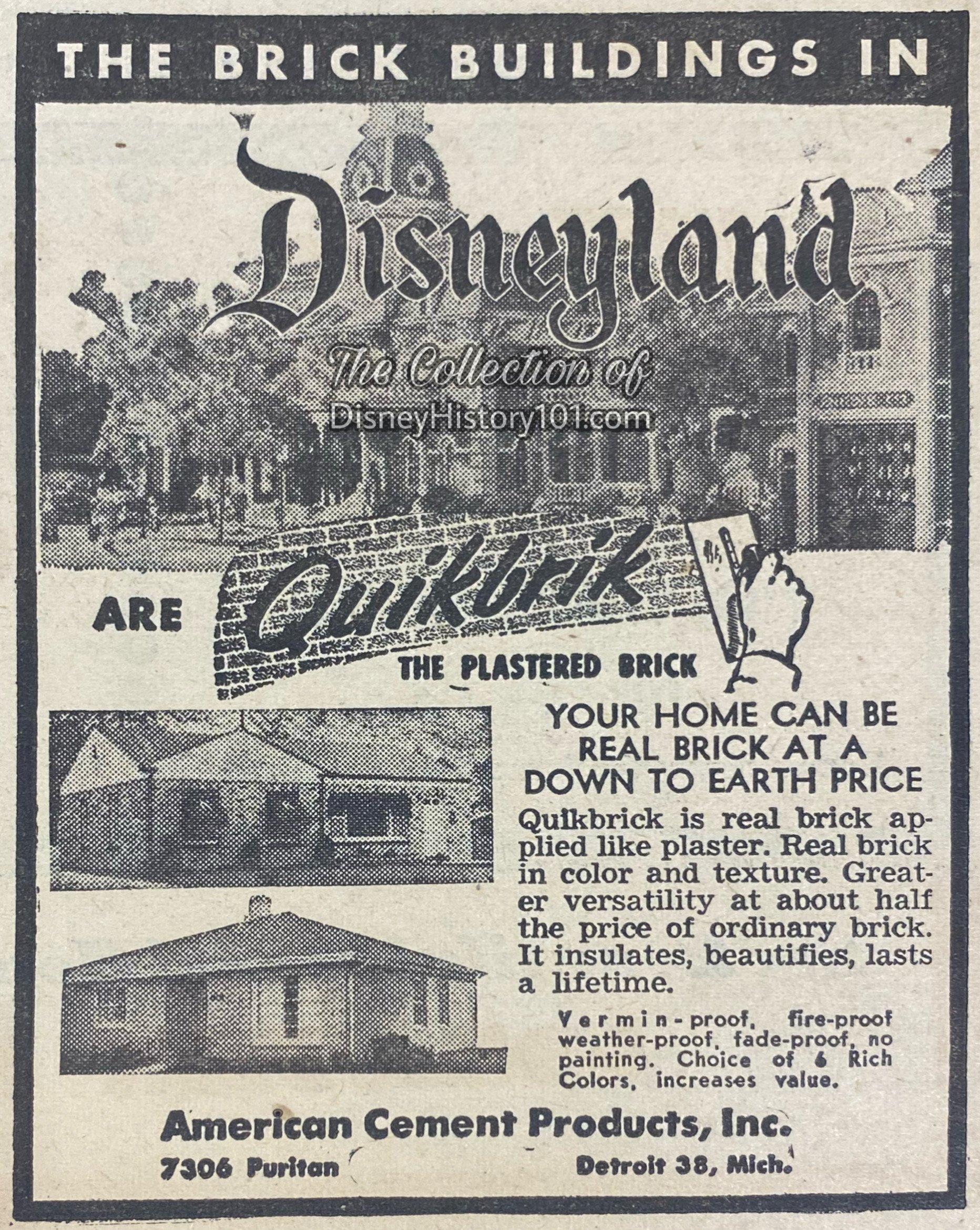
QuikBrik, the official colorful and textural "bricks" that adorned the turn-of-the-century facades on Main Street, U.S.A. at Disneyland.
“Construction”
“Disneyland is unique in that some of the world's foremost creative artists and architects control all design at Disneyland.“ F. M. Franz, manager of operations for McNeil Construction expressed: "We feel sure there has never been anything built like this in Southern California, or elsewhere in the United States. Many of the items were constructed from artist’s sketches.” Forced perspective would make the buildings on Main Street appear taller than actually are. On Main Street the buildings would not be full scale. Ground floors were built about 9/10ths scale. Second floors measured up to 7/10ths scale. The scale on the uppermost floors would be smaller still.
Things did come together and construction began on the most outstanding of Bank of America’s contemporary 550 branches. First, a concrete foundation and slab floors were prepared, followed by wood frame construction (while store units would have a combination wood and rigid steel frame). The buildings of Main Street U.S.A. were all constructed to be very ornate, with variable embellishments.
According to inserts published in area newspapers during July of 1955, Disney buildings were roofed by Pioneer Roof & Shingle Company (then located at 608 Mateo Street, Los Angeles, California; 7522 Westminster Avenue, Westminster, California). The roof covering was a variable, dependent on the architectural design.
The 1,082 square foot space of Main Street Building #700 (as each on Main Street U.S.A.) possessed complete fire sprinkling systems. By June 30, 1955, related Disneyland Site Work Fire Protection Utilities Plot Plans were prepared for Disneyland Inc., by J.E. Thomasson of WED Enterprises Inc.
“Newbery Electric Corp. took the rapid electrical construction of Disneyland in stride. The electrical installations were supervised by Roy J. Gruendler, manager of Newbery's Orange County district office located at 1335 Santiago Ave, Santa Ana.”
Larson Brothers Plastering Company of San Diego was a proud part of Disneyland. The company crafted the ornamental plastering and all brick used at Disneyland (including their amazing new plastered brick veneer).
The versatile Quikbrick (real colorful and textural brick applied like plaster) was about half the price of ordinary brick. It insulated, beautified, and was meant to “last a lifetime.” It was used on the facade.
As of June 2, 1955, C.V. Wood Jr. sent an Inter-Office Memorandum to Walt Disney regarding the best estimates that could be obtained at the time regarding the completion status of individual sections of the Park and Opening Day. C.V. wrote: “Building #708 - Bank of America: This one will be very difficult to complete by opening day. We will take another reading in about three weeks to decide what actually we should take regarding dressing.”
By July 2, 1955, shadow gags were ordered. Painted signs, window, curtains, and shades were projected to be completed on time. The sound equipment was be installed, with completion of the tape recordings appearing to be fairly tight. The electric signs were “in work,” with the exception of two shops (the shoe store and the Bank of America), all would be completed.”
“Casting”
Walt (and company) always recognized that casting was essential to the success of any story being told whether in feature-length and short film format, or at Walt Disney’s Disneyland. As far as those Disneylanders representing both Walt Disney Productions and lessees on a person-to-person basis, Walt later expressed the following confidence: “What you do here and how you act is very important to our entire organization and the many famous names of American business represented among our exhibitors… Your every action (and mine also) is a direct reflection of our entire organization… For our guests from around the world the curtain goes up on an all new show at Disneyland everyday and you, as a host or hostess, are truly ‘on stage.’ I know you will give a courteous and friendly performance.” Now, as with all Disneyland Hosts and Hostesses hired during 1955, each aforementioned employee of the Bank of America Disneyland Branch was “hand-picked by Disneyland officials with qualifications including disposition, general attitude and appearance. Each new Disneyland employee was required to attend ‘orientation classes,’ part of a training course in Disneyland policies, to become acquainted with the Disneyland way of life,” according to “Building A Dream,” prepared by Disneyland, Inc. Public Relations Department, c. June of 1955. Five months before the premier opening of Disneyland, Hal Hensley (of the Disney University Orientation Program) held classes to instruct some outgoing and friendly 1,200 Disneylanders (including those fulfilling roles at Bank of America) in some of Walt’s personal philosophies, as well as the policies which would “create happiness” for visitors! Despite their 1890 On Stage setting, Hal wanted Disneylanders to “get a ‘new world’ feel about this place.” The result was that even at its foundation in 1955, Disney University was investing in the “skills bank” and producing specialists in the field of outdoor theme entertainment.
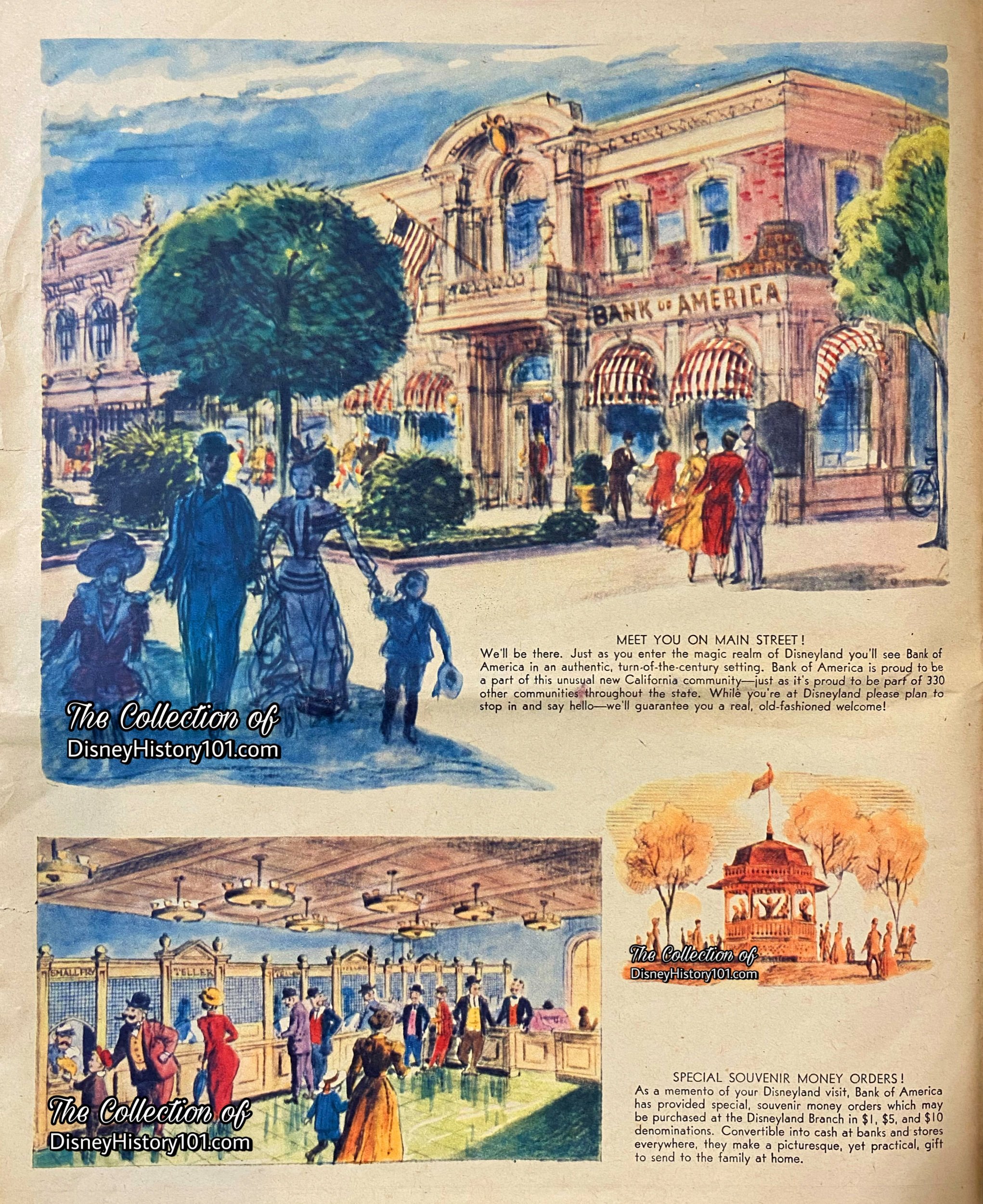
Bank of America’s “Disneyland” Partnership included in an Excerpt published for newspapers, July 15, 1955
“Grand Opening”
A contributing writer of The Daily Oklahoman (who visited Disneyland on July 17, 1955) noted: “The guests walked into a city square of the 1900 era, bounded by an old time railroad station, city hall and fire station, opera house and other vintage merchant houses.”
Bank of America was situated next door to Town Square Realty (under the Disneyland PBX officers), on the 600 block of Main Street U.S.A., Disneyland. But this 1,082 square foot Bank of America would be unlike any other, for “it must be in keeping with the era,” according to Walt to Bob Thomas (of Associated Press) in one pre-Opening Day interview. Soon newspaper readers (e.g. those of July 15, 1955, advertisement supplements of the “Register” of Santa Ana, California) were treated to a preview of this particular facility, as it’s character design was fashioned after an 1890-era Bank of America branch! One article promised “Except for escrow service and safe deposit boxes all the services of the statewide banking firm are to be offered. Most popular should be the brightly colored souvenir money orders, which visitors can send home to family and friends. Issued without a service charge in denominations of S1, $5, and $10, they are imprinted with pictures Disneyland Mark Twain river. boat, the Santa Fe-Disneyland railroad, and the bank itself. They are as cashable in the ‘outside world’ as other money orders.”
Opening Day festivities were led by Leo Wagman (Assistant Cashier), and three male tellers - Dick Sanderson, Dick Wright, and Keith Laing. One of the few resources (about opening day) which we discovered was an article entitled “Banking in Magicland.” This article preserves two fantastic photographic memories - one of Dick Wright helping one of the first customers “David Beltz, 5-year-old son of Anaheim Pro AC [Assistant Cashier] Howard Beltz,” standing next to “Buddy Baer, posing as sheriff, while Kit Fox, chief of the Comanches, stands behind David.” The other photographic memory is that of the “first shipment of silver dollars… unloaded from coach in front of our Disneyland branch with ‘Sheriff’ Buddy Baer and under the watchful can-can girls from nearby Golden Horseshoe.”
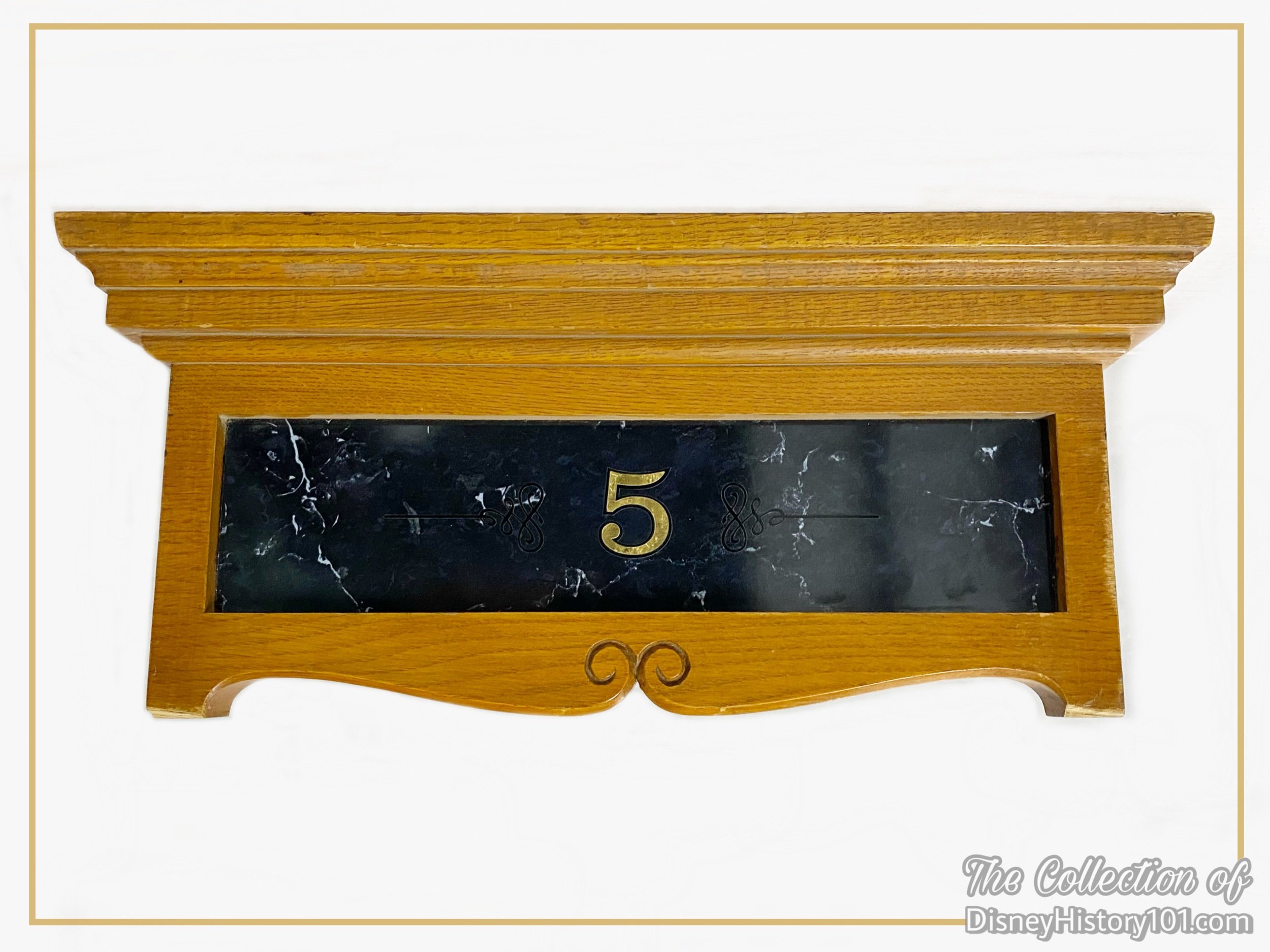
Bank of America Teller Window Number “5.”
“Bank of America - The ‘Showpiece’ & The True-Life ‘Institution’”
As Van Arsdale France (founder of the University of Disneyland) explained in that presentation for potential Disneyland Participant sponsors (in May of 1955): These top executives of major American corporations were “here not to make money” but because they were to “create happiness!”
While the Disneyland, Inc. Public Relations Department reports referred to the “Banking Operation” (located on the 700 block of Town Square), the 1,082 square-foot “exhibit” was still reckoned among “Disneyland rides and amusements”that would “delight the very young, the teen-ager, young married couples, the middle-aged, and grandparents alike.” Some of our Vintage Views would testify to this fact [e.g. the excerpt from the Anaheim Bulletin “Premier Souvenir Edition - Walt Disney’s Magic Kingdom - Disneyland” Insert ; Friday, July 15th, 1955].
As was the case with the local Upjohn Pharmacy exhibit, the Disneyland Bank of America Branch was a “showpiece” with a“unique, old-fashioned atmosphere.” Stepping through the doors, one would notice that all fixtures were placed in their correct motif and many light fixtures were authentic antiques. The furniture and banking facilities matched those of the 1900’s. Owing to Imagineers knowledge of their guests, Grandmother or grandfather would have recollections of the chandeliers, teller’s cages, the interest calculator, the old-fashioned adding machines, old-time telephone, the antique 1890-period Remington typewriters, and the huge vault door (“taken from a 1911 Monrovia, California bank,” according to Vacationland magazine, Winter/Spring of 1965). Even Roy Disney (who once worked eight years for First National Bank of Kansas City) may have felt a little nostalgic over what he saw.
A few months later the Disneyland Bank of America Branch was a well-established and fully-staffed branch. Western Banker magazine Vol. XCV, No. 3 (published September of 1955) featured the Bank of America lobby on the cover, along with it’s “Pro-Assistant Cashier (Harry Kenawell) and perhaps some of it’s earliest tellers (Dick Sanderson, one of two female tellers Anne Richmire, and Keith Laing). In 1955, these were now led by Les Wagman, Assistant Cashier, Disneyland Bank of America Office manager, and first president of the Disneyland Merchant's Association. In this “last-century atmosphere,” some of these wore “shirt-sleeved tellers wearing vests, string ties and eye shades,” and worked “among old-style adding machines, typewriters of 1880 vintage, high stools and bookkeeping desks while supplying up-to-date banking service to visitors, the Disneyland owners, the business houses, concessionaires and their employees,” according to the very same article. Les Wagner’s position was truly unique, as he was “the only officer heading a Bank of America branch who is supervising modern banking service amidst surroundings of 60 years ago. It is all part of the schema of things carried out in the Magic Kingdom of Disneyland.”
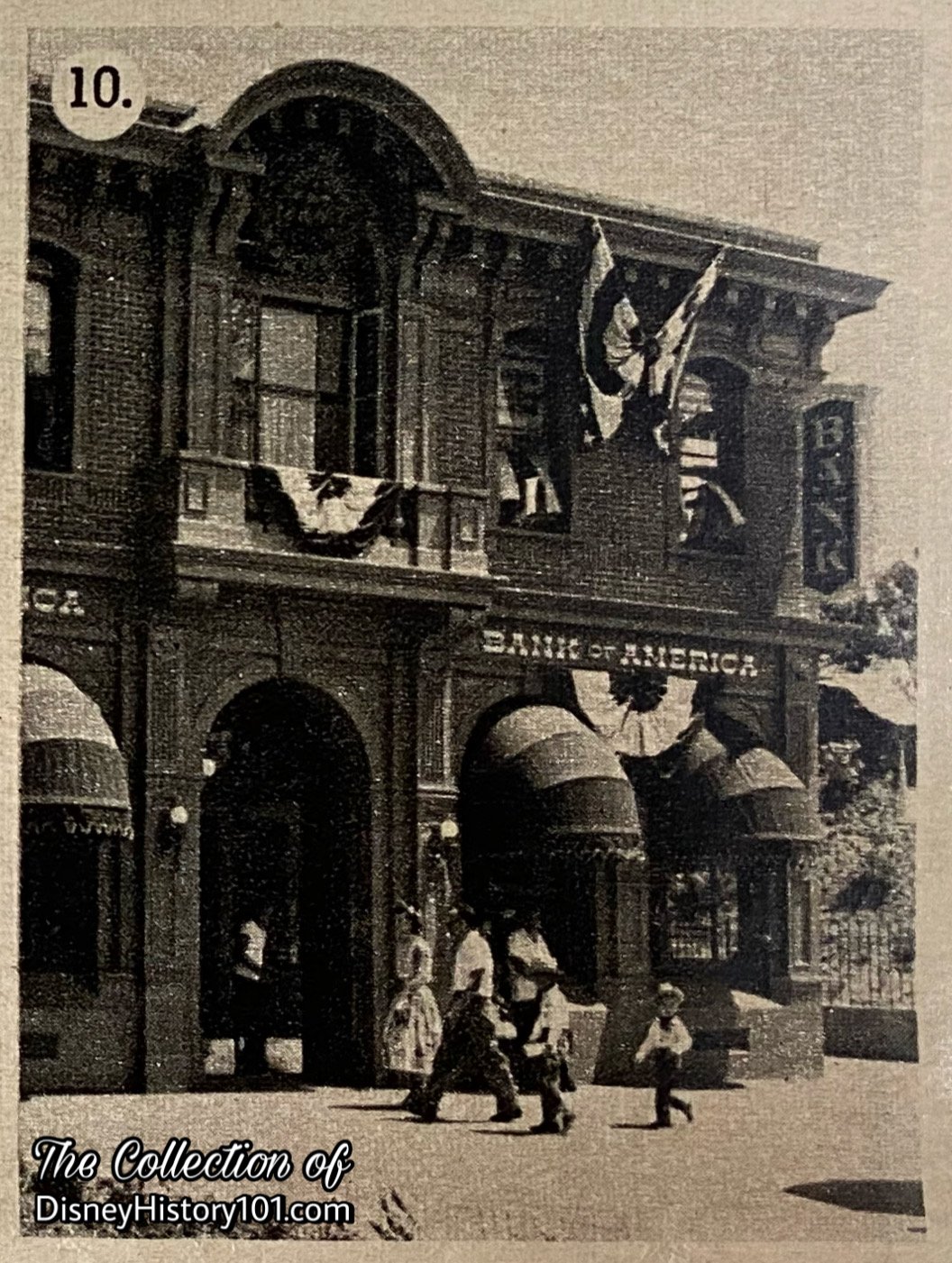
Bank of America Architectural Facade was notably seen in the “Disneyland 1st Anniversary Souvenir Pictorial”
“The True-Life Institution”
This Bank of America Branch was “a real institution,” “fully equipped, completely modern.” Disneyland planned for a 7-day schedule, 10 a.m. to 10 p.m., through summer, closing Mondays as fall approached. But ultimately the branch would open daily (from 10 a.m. to 4 p.m.) for Disneyland guests to perform business or explore.
In exploring the “free exhibit” - this authentic recreation of a “pony-sized” bank (complete with antique safe) - guests may perform their business! Guests could open a savings account or commercial account, take out a loan, make change, cash checks or take home a Special Souvenir Bank of America Money Order (featuring artwork of the Disneyland bank of America Branch facade, the Mark Twain, or the C.K. Holiday engine)! One, five, and ten dollar money orders (for use at “stores, shops, banks, or anywhere in the nation”) were available without charge at your Disneyland Bank of AmericaBranch! The latter were so popular that they “passed the 1,500 mark on the fourth day of business,” according to “Western Banker” (Vol. XCV, No. 3). Guests may also remember receiving their official Disneyland Bank of America photo checks if they banked here during this historic time. Now, the adults typically performed the family’s banking. So, for the kids, there was “a special ‘small fry’ window where the bank passes out foil-wrapped chocolate ‘gold pieces’” which attracted many young “bankers.” After business was performed, guests would often sign “an old cash book ‘guest register’ inscribed ‘Our Greatest Assets Are Our Friends.’”
All of this would create tangible memories Guests through it’s merchandise and show!
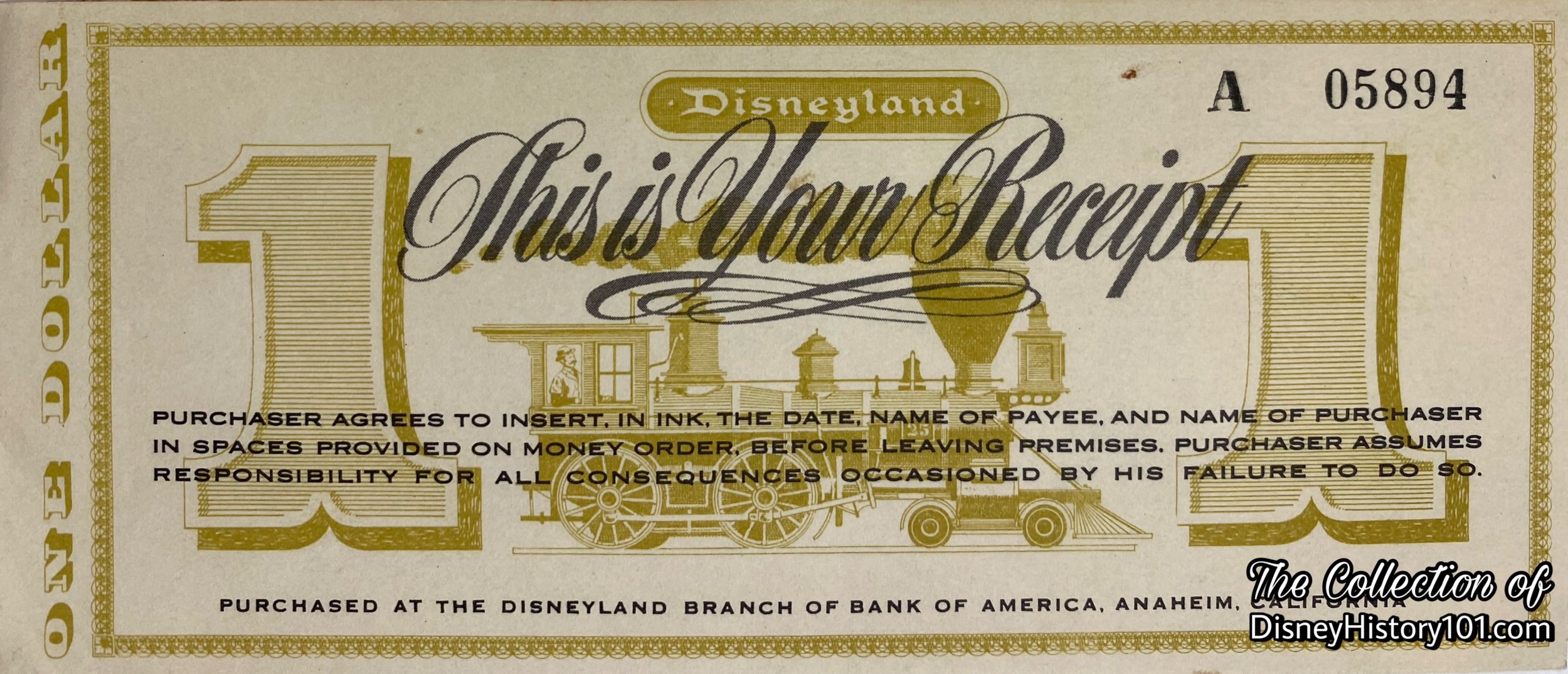
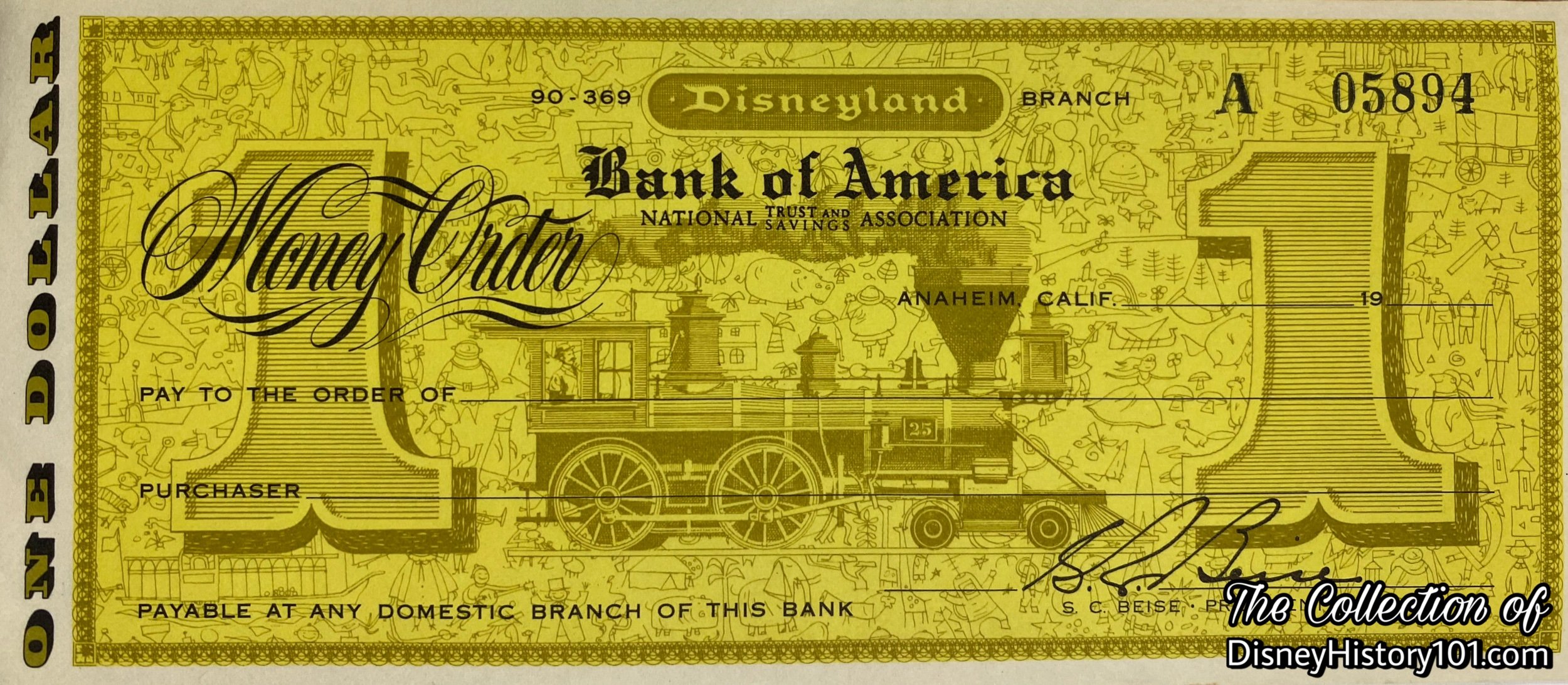
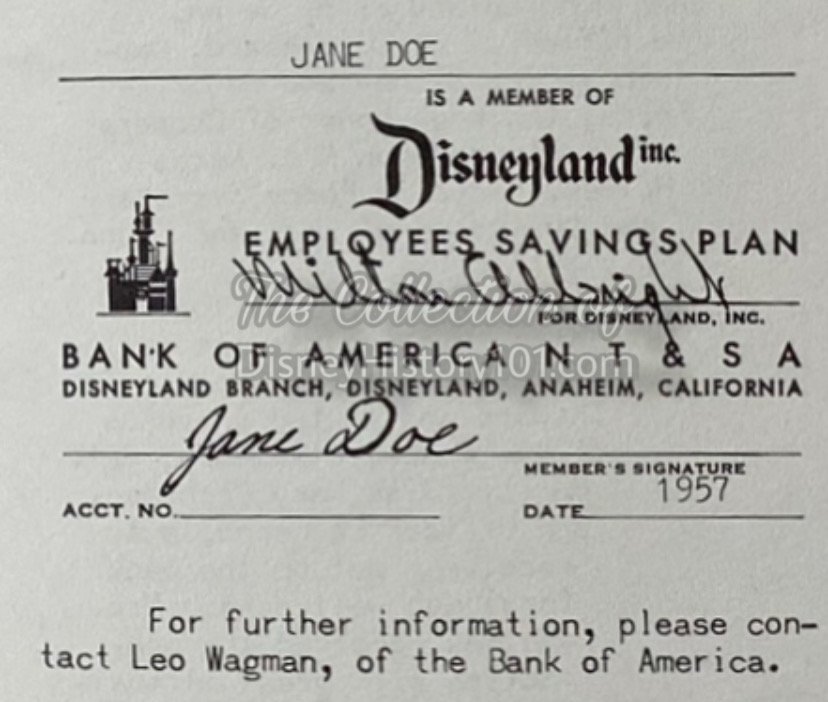
The Bank of America Employee Savings Plan is promoted in the Disneylander, May 1957; Page 14
“Service à la Disneyland”
As for “Disneylanders,” you may recollect once using this bank to do your personal banking, long before there was a credit union. In fact, Disneyland Employee Paychecks of the era even bore the Disneyland Branch of Bank of America logo under The Walt Disney Productions logo. An issue of “The Disneylander” (1957; Vol.1, No.5) ran an ad and short article offering the Employee Savings Plan financial product, stating:
“The Company recognizes the value of a systematic savings plan for its employees, therefore, in conjuntion with the Bank of America, has worked out a program whereby each employees may save through the medium of automatic payroll deductions. In order to participate in this plan, all you have to do is stop at the Bank of America and fill out a card (like the one shown below) authorizing the Disneyland Payroll Department to withhold from your paycheck, the amount you wish to save each week. The amount that vou authorize will be deposited to your account and a Savings Pass Book will be mailed to you after the initial deposit is received at the Bank. Your savings will continue to accumulate without any further action on vour part and will earn the regular 3% interest rate.”
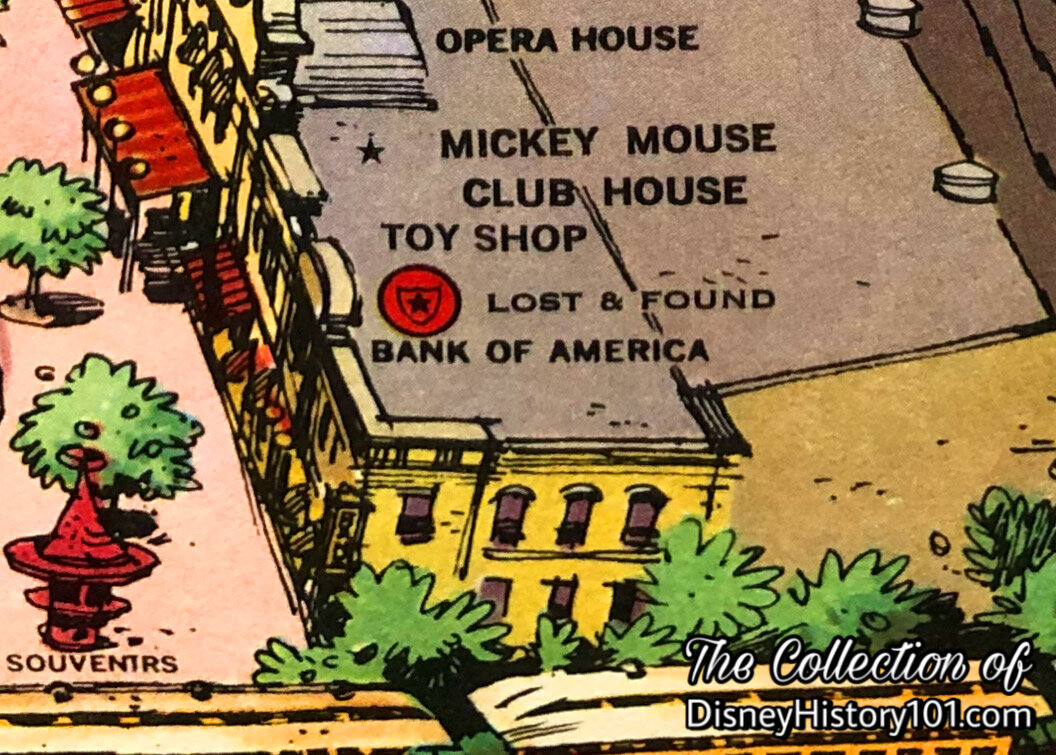
“Disneyland Bank of America Branch” Detail, Disneyland Map by Sam McKim Excerpt, (1964)
The synergistic relationship between the institutional lessee and Disneyland was beneficial. Bank of America yielded some revenue for Disneyland Inc. - $21,512 for the fiscal year ending September 29, 1957 and $21,520 for the fiscal year ending September 28, 1958. By 1958, the Bank of America Disneyland Branch was considered one of 15 free educational shows and exhibits at Disneyland.
By 1958, Bank of America appraisers figured of the total income received from leases, 16.02% was derived from the selling of advertising rights and 40.12% from the leasing of space to concerns whose main reason for occupancy is for advertising purposes. The remaining 43.86% of the lease income was derived from stores that sell various products and food. As much of the income was acquired by Disneyland, Inc., it is clear that Participant sponsors were still here to create happiness!
In fact, by October of 1959, there were over sixty-eight other firms playing a vital part in the team effort to bring happiness to Disneyland’s Guests. Some were small, specialized individual operators; some were huge companies such as Swift & Co. - the Bank of America - United Paramount Theaters (which you hear as UPT) - Carnation - Richfield - General Dynamics - Crane - and many others. These companies used the park to publicize their wares, leased space in the Park to sell their wares, and Disneyland collected advertising fees from them.
During 1959, Bank of America was open from 10 a.m. to 4 p.m. every day the Park was open, Selling Disneyland Money Orders and offering free Disneyland maps for Guests.
The previously stated unique hours of this Bank of America Disneyland Branch continued in the 1960s. According to the Guided Tour Script of 1962 : “Across the street is our Bank of America, open for your convenience until 4 o’clock this afternoon. This bank is unique in that you may do your banking on Saturday, Sunday, or Holidays…anytime the park is open.” By this time, Bank of America boasted “more than 600 branches,” some in “more than 330 other communities throughout the state.”
By 1965, Bank of America was accounted among Disneyland's 29 Institutional Lessees.
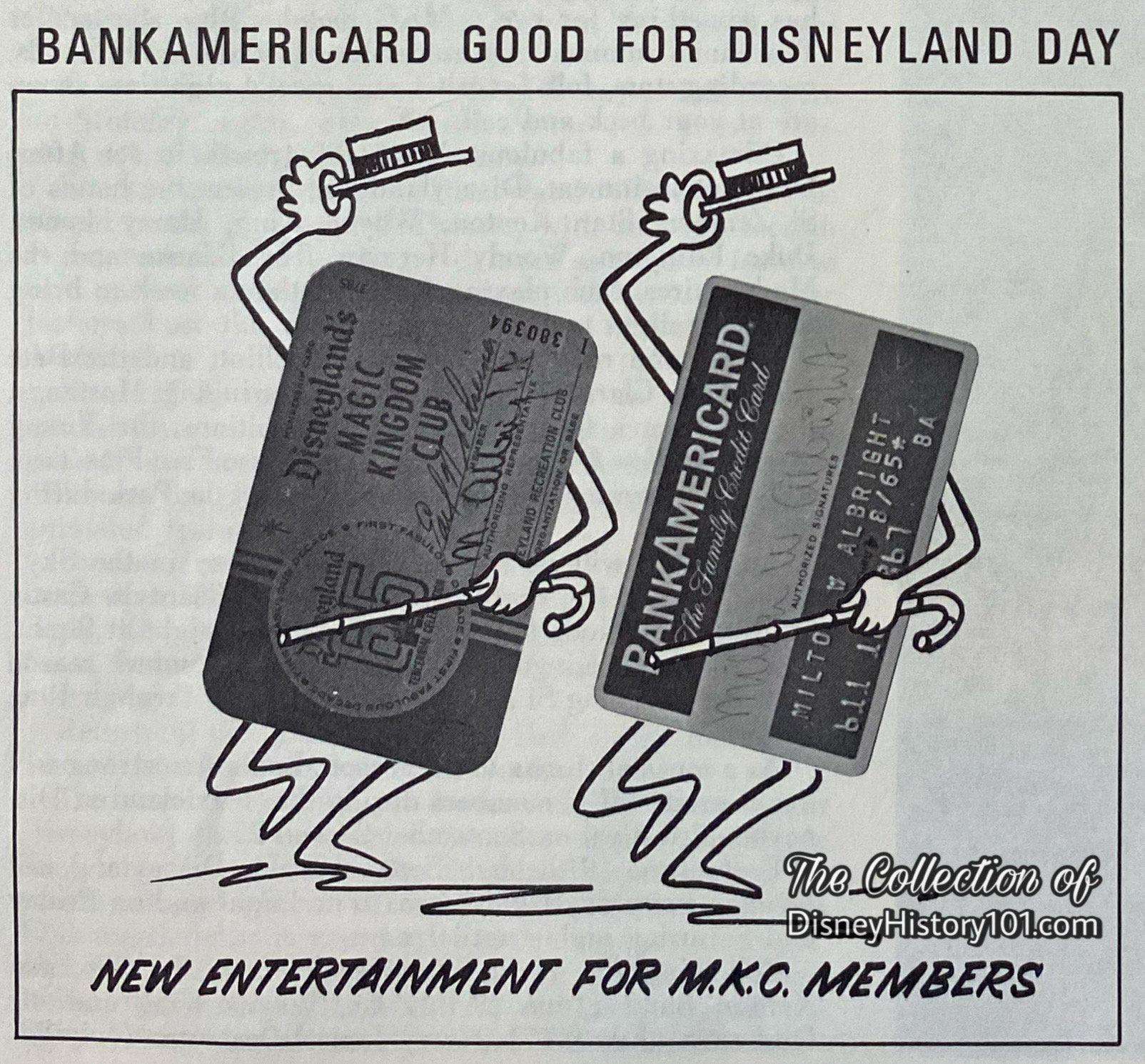
BankAmericard advertisement in Vacationland, Winter/Spring 1965.
During the late 1960’s, BankAmericards could “be used to purchase Disneyland admission and ticket books at any branch of the bank and may also be used to purchase food and merchandise at any shops in Disneyland,” according to the “Disneyland Dictionary” (compiled by WED Enterprises, Inc. and WED Public Relations Department, c. 1968).
Check Cashing Bank of America Hours were 10:00 A.M. to 4:00 P.M. After Bank hours, guests were directed to the "Great Moments With Mr. Lincoln” Ticket Booth.
Out-of-state visitors on a holiday would have especially appreciated the convenience owing to these previously stated features and accommodations of the Disneyland Bank of America branch. In fact, It seems that escrow and safe deposits were the only products or services that were not offered through the Disneyland Bank of America branch.
By 1975, Bank of America was open when the Park was open; 10 - 3 daily. This was perhaps the only bank in America open on Saturdays. Sundays and Holidays. Disneyland Guests who wished to cash checks when the bank was closed were directed to the Main Street Railroad Station Ticket Booth and the Penny Arcade.
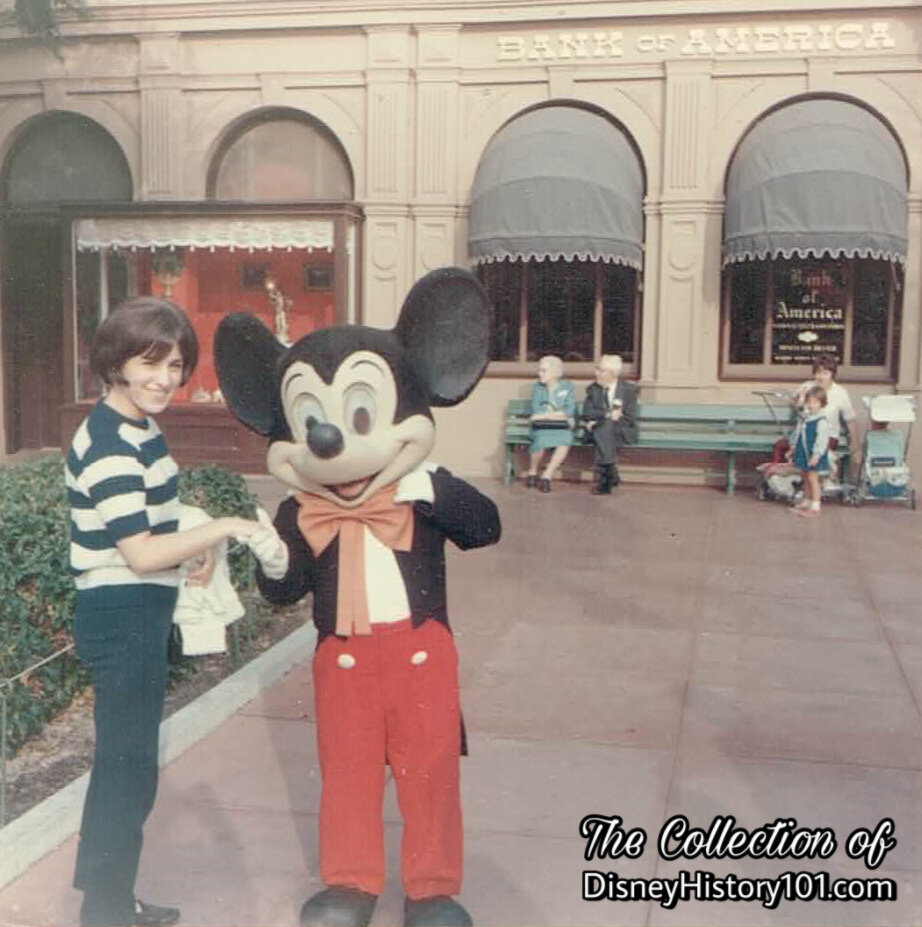
Bank of America, Disneyland Branch, 1966.
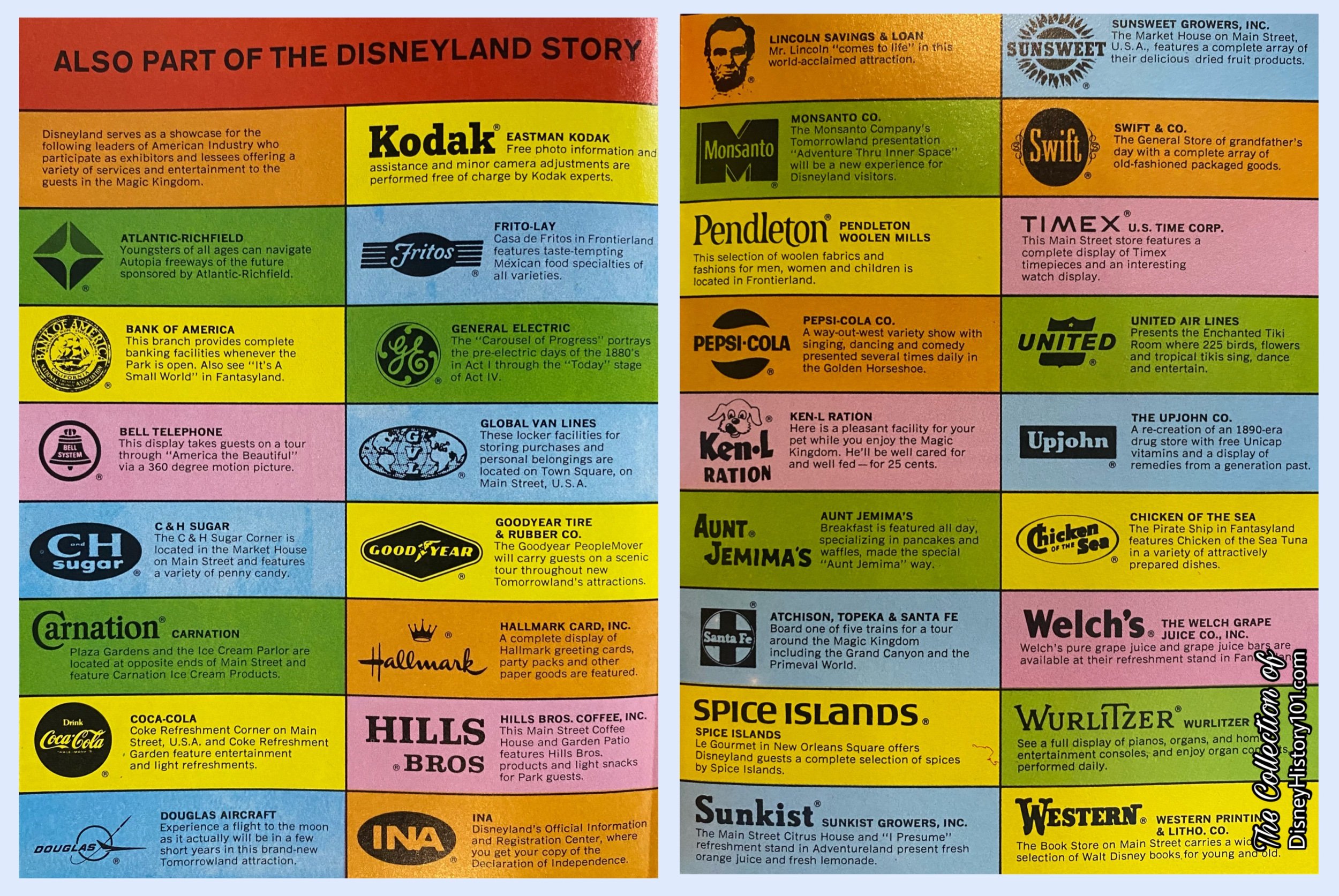
Bank of America was a Disneyland Participant and thus “part of the Disneyland story according to this “Disneyland ‘67” Excerpt.

There are many stories to tell about the construction period, like the time that Mill workers had to be safe crackers when the Bank of America vault was stuck. Another story includes laying the structural foundation.
“RHONDA RECOLLECTS A.E. FOWLER AND SONS INVESTMENT - IN LAYING THE FOUNDATION”
“Father worked for A.E. Fowler and Sons as a construction worker and crane operator. They did work all over Orange County. After laying a bank building foundation, Father would throw a penny in the wet cement. Later, he liked to humorously tell people, ‘I have money in THAT bank, and THAT bank, and THAT bank.” We wonder if Crane Operator Ron Vasey STILL has money in Disneyland’s Bank of America today!
“MARY REMEMBERS THE BANK OF AMERICA VAULT INSTALLATION”
“My dad was part of the crew that installed the vault door…Dad worked for the Bank of America. That was the original purpose of the building, a real bank.
I was not present at the time. I would have been 12 years old. I feel some pride about it now, but back then, I didn’t give it much thought. I am not aware of any other things he did for Disney. He did act as technical adviser for a couple of movies regarding vaults and safe deposit boxes.
Many years later, my daughter worked the part of the Queen of Hearts character in a parade. I took my parents over to see her and my Dad went to the old Bank [of America] building. He was looking at the vault and the young woman who worked there came over and asked him if he had installed it. I thought it strange that she would ask that.”
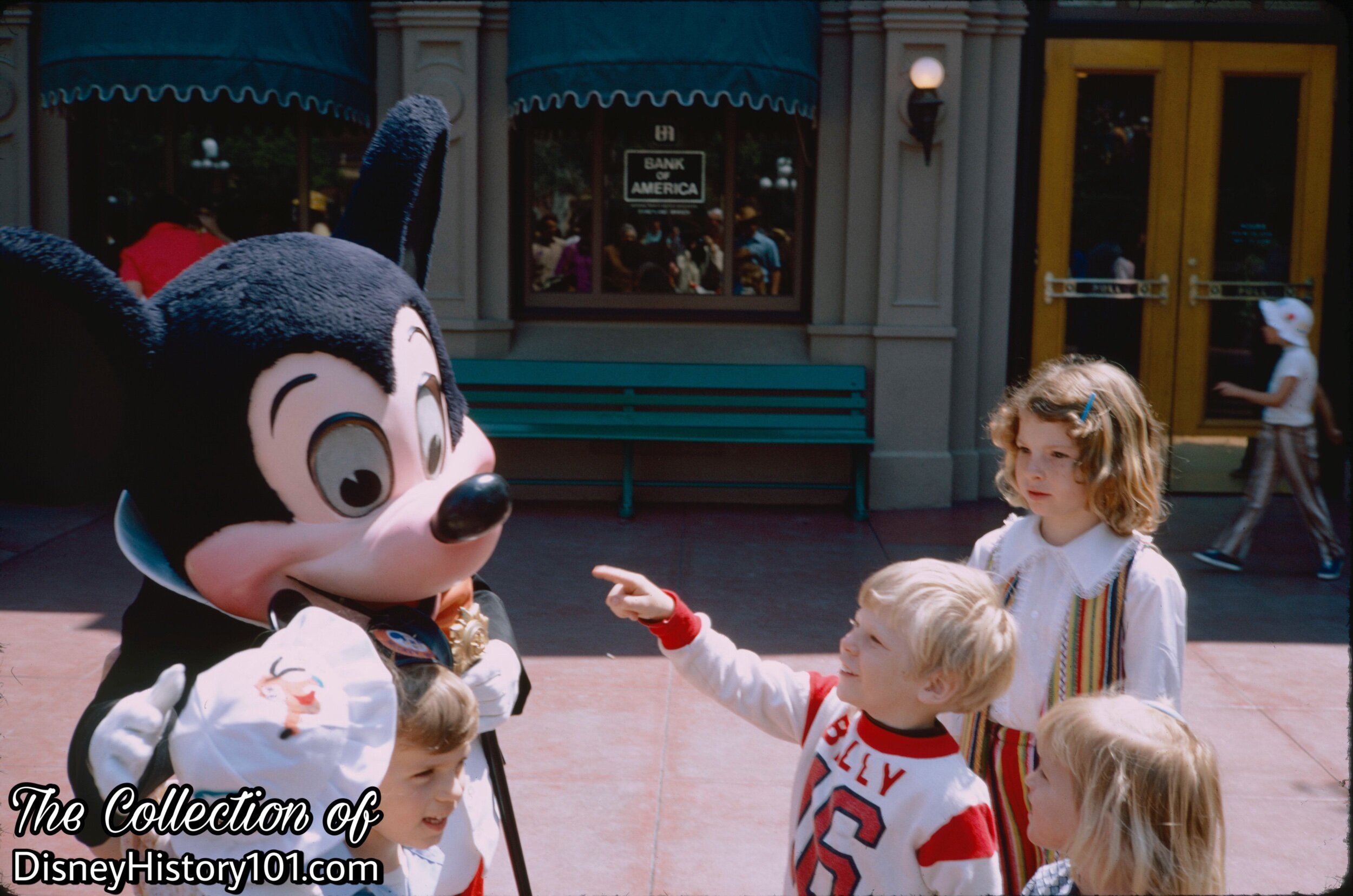
Bank of America, Disneyland Branch Architectural Facade, April, 1972.
Mickey Mouse greets guests in Town Square, in front of Bank of America.

Bank of America, Disneyland Branch, Architectural Facade, August, 1975.
Here’s the Disneyland Branch of Bank of America, all decked out in red, white, and blue bunting for the American Bicentennial celebration held in Disneyland!

A window display near the Bank of America Disneyland Branch.
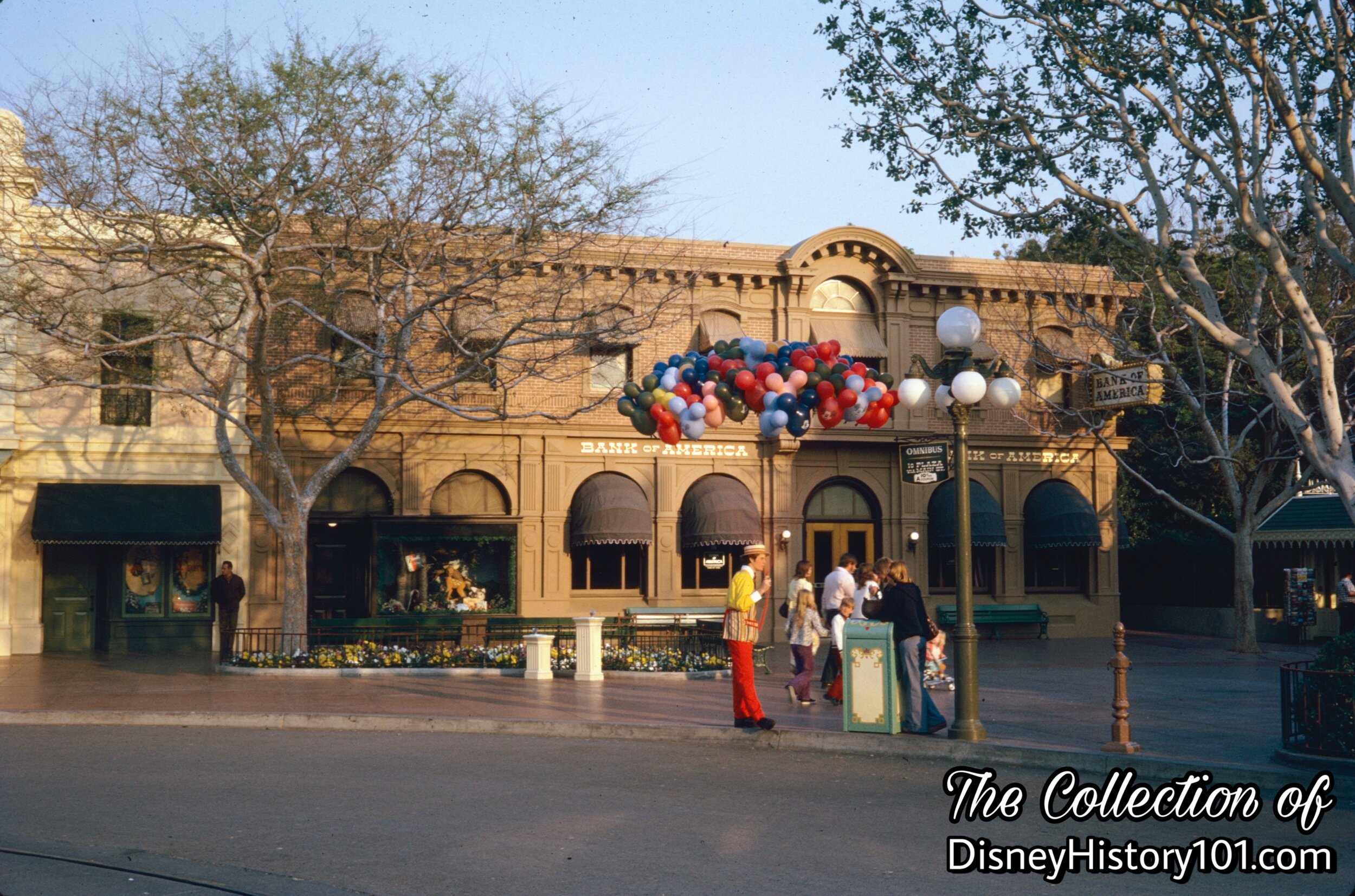
Bank of America, Disneyland Branch, Architectural Facade, c. 1970s.
“A ‘Bank Note’ on Mickey’s Mint & The Versateller”
According to Disneyland LINE (August 5, 1976), “the Main Street branch outgrew its facilities as it strived to take care of both guest and employee needs, so in 1974, Mickey’s Mint, the only bank branch in California exclusively established to serve the employees of one company was opened”. By 1976, there were 27 Bank of America employees (working various hours, seven days a week) at both “Mickey’s Mint” - the newest Full-service Disneyland Park Bank of America Branch, and the Federal Credit Union branch (adjacent to the old Pony Farm).
The following year (of 1977), the Bank of America’s hours of operation were adjusted to 10a.m. to 3p.m. However, (by a special arrangement) check cashing with proper identification (up to $10 cash) was a service made available at select ticket booths including the Main Street Station Ticket Booth. In addition, BankAmericards were accepted at most shops, stores and restaurants at Disneyland bay this time. For Cast Members, Bank of America offered complete banking services from this fully-operating branch of the Bank of America. Located in the Backstage area between the Main Street break area and the Center, “Mickey's Mint” as the branch is nicknamed, had been serving Disneylanders since October 14, 1974. It was also the only bank of its kind in the United States that served strictly the employees of a large company. The bank’s operating hours are 10 am to 3 pm, Sun., Mon., Tues., Thurs., and Sat; 11:30 am to 6 pm on Wed.
only, 10 am to 6 pm on Fri. only. The bank is closed on holidays.
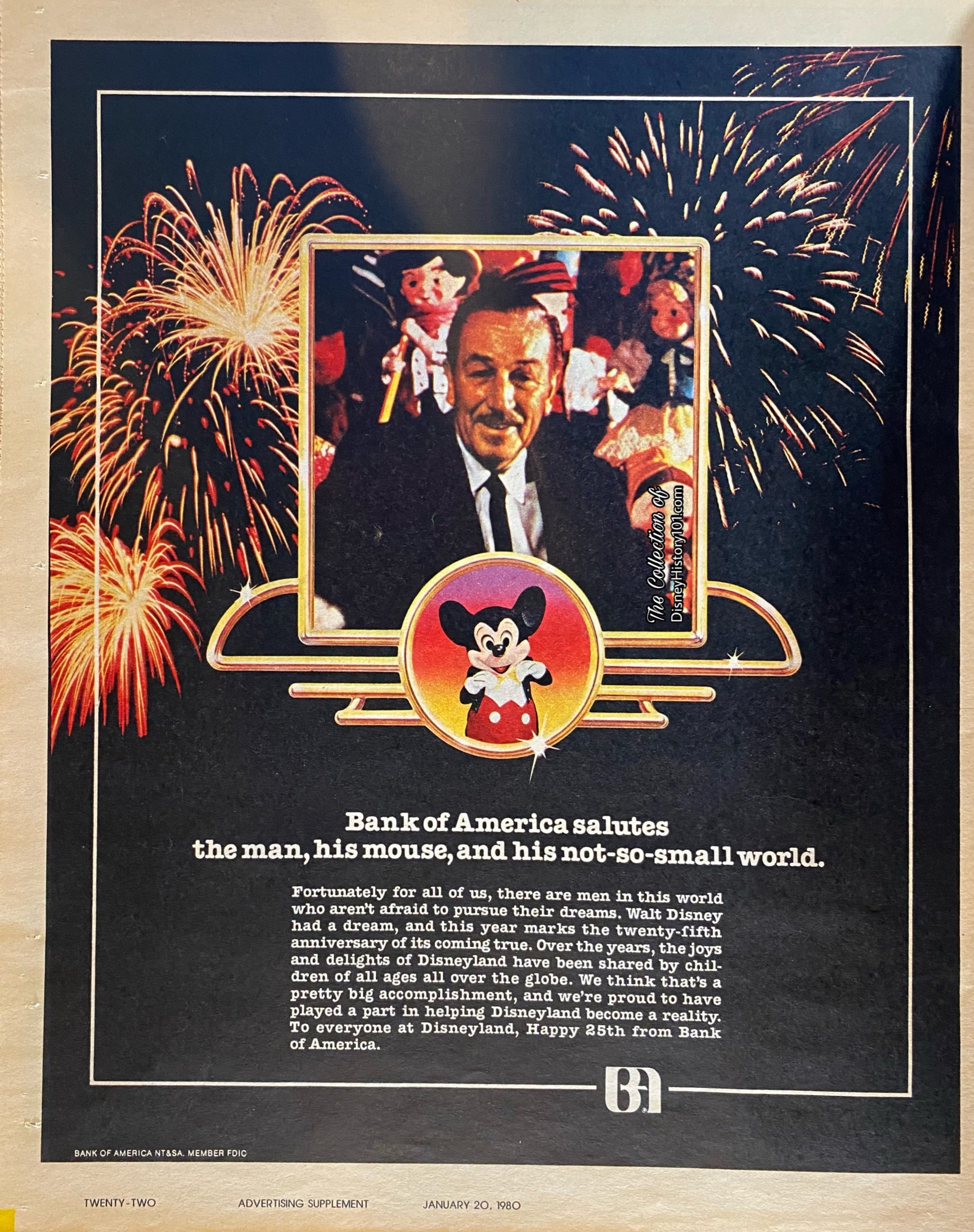
“Disneyland 25 - Happy Birthday to a Dream” Supplement, published approximately January 20, 1980.
Mickey’s Mint ceased operation on September 1st, 1980, and Disneyland Cast Members soon scrambled to have their accounts transferred elsewhere to accommodate their banking needs (as the Main Street Bank of America was not a full-service branch).
By 1984 a Bank of America Versateller was conveniently located (between Group Sales and the Information Newsstand) just left (west) of the Disneyland Main Entrance. Guests who wished to cash checks when the bank is closed could be directed to the Penny Arcade on Main Street or the Starcade in Tomorrowland. There was a $20 check cashing limit.
By 1990, a Bank of America Versateller was located west of the Disneyland Main Entrance. But three years later (after some 38 years), Disneyland Participant Affairs and Participant Bank of America could not negotiate a new cooperative agreement to maintain their ongoing relationship). So, the opening-day sponsor would depart from Disneyland. Though the Disneyana Shop would swiftly move into its place, Bank of America’s years of loyal service, free exhibits, and other Disneyland investments were missed by both Disneylander and guest alike! Cast Members may recollect the TEAM Center was once located on the second floor of the old Bank of America building.
The 1990s saw a massive rehab to Main Street U.S.A.’s facades, and among them, some of the biggest changes to the Main Street fixture. With the advent of ATMs at Disneyland (in 1993), the institution of a bank became redundant. That year, the location was converted from a commercial bank, into an Annual Pass Center.
Within a few years, it was decided to add a distinguished marble facing by “aging and grain” specialist, Doug Price of Disneyland Staff Shop. By 1999, the biggest change was in store - that of sponsorship for Bank of Main Street. A deal agreed to in late March of 1999 saw Union Bank of California (a member of FDIC) become the official bank of Disneyland Park. During the era, you may recollect visiting the Bank of Main Street for a souvenir pressed penny, and a souvenir Disneyland & Union Bank of California commemorative sleeve.
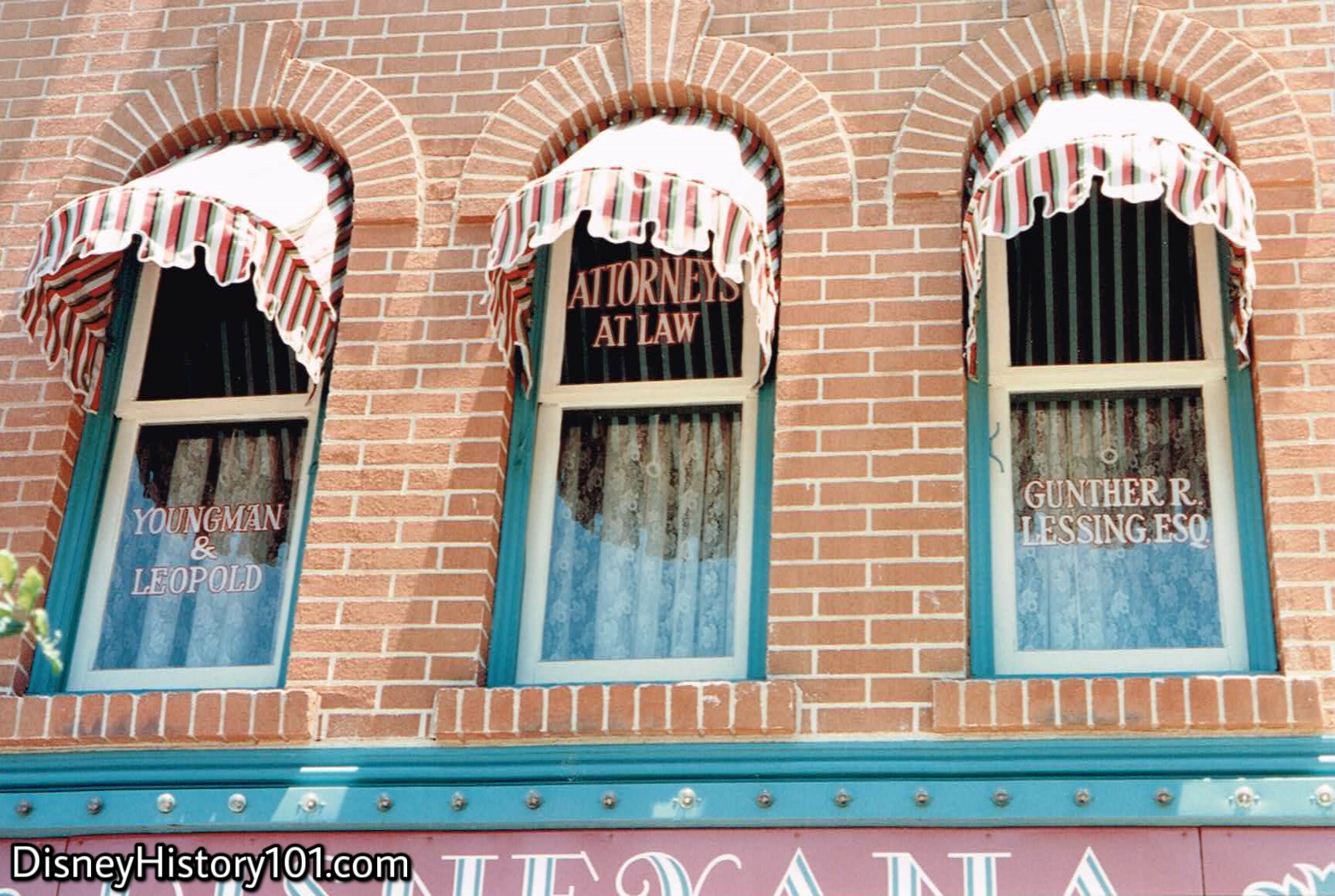
Main Street Window Honors Over Bank of America
“We celebrate our people for the memories they created in the past.”
There are thousands of windows at Disneyland. Most Guests strolling down Main Street, U.S.A. only notice that the fanciful window advertisements above the attractions, stores and restaurants add a nice, decorative element that completes the turn-of-the-century theme. But most Disneyland insiders know that some of the windows also serve a dual purpose of honoring Disney Cast Members who helped make Disneyland a beloved institution.
Martin Sklar once said “an individual's contribution can usually be found in the final product if one looks closely enough, but the Disney mind frame is to never point out ‘what I did’ to anyone.” However, a few outstanding individuals have been publicly recognized for their contributions and even ceremoniously honored by the Company.
“The legal profession is recognized on the windows above the Disneyana Store which read: Gunther B. Lessing, Esq., Youngman and Leopold. Gunther Lessing served as legal counsel to The Walt Disney Company for more than 30 years. Youngman and Leopold, members of the same legal firm, played important roles in early negotiations of Disneyland,” according to “Disneyland - A Treasure Chest of Trivia,” prepared by Walt Disney Productions, 1990.
Other windows (not pictured above) feature the names of William T. Wheeler & John Wise (of Wheeler & Gray Consulting Engineers). They both were instrumental in creating Disneyland, and John Wise went on to become WED’s chief engineer for future projects. As for Bill, he led design teams that were instrumental to the Disneyland we see today, and also to Disney World and Epcot Center in Florida. William and John were not the only two Wheeler & Gray engineers to join the Disneyland Team or make contributions to the magic kingdom. For instance, Don Edgren started work with Disneyland in 1954, performing “structural designs and installations at Disneyland,” according to his WED Capsule Biography. “Coordinating the engineering for Disneyland’s Matterhorn, Monorail, and general facilities, Don acted as liaison between Wheeler and Gray before he joined the WED staff of designers in 1961. His first project after coming to WED was the Swiss Family Treehouse, one of the most interesting structural engineering projects at Disneyland, basically constructed and patterned after a scale model.” Another unsung engineer was Hector Abdullah, who was contracted by Wheeler & Gray Consulting Engineers, when a pre-construction stress analysis of the Swiss Family Robinson Treehouse needed to be conducted. While Don received a window honor, Hector did not (as he was only a contractor).
J.S. Hamel, Consulting was an appointed consulting engineer for the Disneyland project in 1954.
Seven Summits Expeditions, Frank G. Wells, President - Wells, who climbed the tallest mountain on six of the seven continents, was President of The Walt Disney Company from 1984 until his death in 1994.
Richard Irvine and Marvin Davis, Architects and Associates - Irvine was chief of designing and planning for Disneyland, Walt Disney World, and the Disney shows at the 1964-65 New York World's Fair. Davis was an architect and set designer who assisted Walt Disney and Richard Irvine in the earliest layout of Disneyland.
Wilson Martin - Art director and project designer on numerous attractions including Sleeping Beauty Castle, Monorail, and Pirates of the Caribbean.
Gabriel Scognamillo - Art director who worked on Tomorrowland.
Wade B. Rubottom and George Patrick - Rubottom was an art director who worked on Main Street, U.S.A; Patrick was an art director who worked on Frontierland
Another notable Disneyland designer who has a window homage over the Bank Building is art director Gabriel Scognamillo (who contributed many Tomorrowland designs, like the yellow awnings that shaded merchandise and concessions, the maritime flags over the Tomorrowland Exhibit Halls, and even the Richfield Autopia marquee and Entrance)!
According to Disneyland LINE : Richard Irvine and Marvin Davis (whom also have “offices” above Bank of America),“are listed among the Architects and Engineers on a window above the Bank of America in Town Square. Irvine was chief designer for the Disneyland project, and is now Executive Vice-President of WED. Marvin Davis, Disneyland’s initial master planner, is a project designer at WED today.”
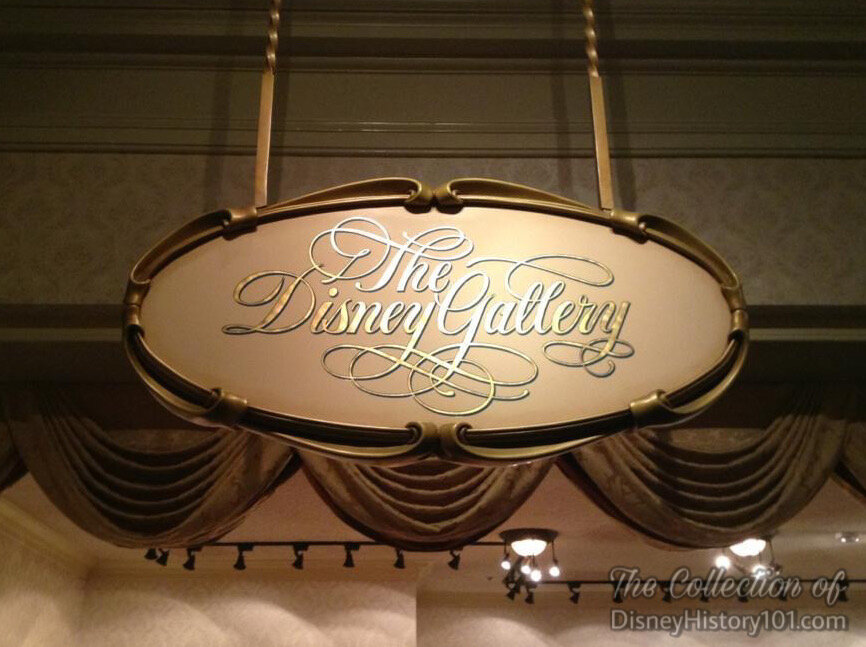
"The Disney Gallery" Sign
In 2008, WDI master plans entertained the concept of a synergistic opportunity possibly involving Visa and Chase Bank sponsorship of the Main Street Bank. This was in development. But in the end (and since its opening in 2009), The Disney Gallery has resided in the location of the original Disneyland Bank of America Branch (later expanding into the Main Street Opera House Great Moments with Mr. Lincoln Pre-Show Area).
In the “Front of House,” a few architectural elements remain to this day, including a portion of the counter and even the vault.
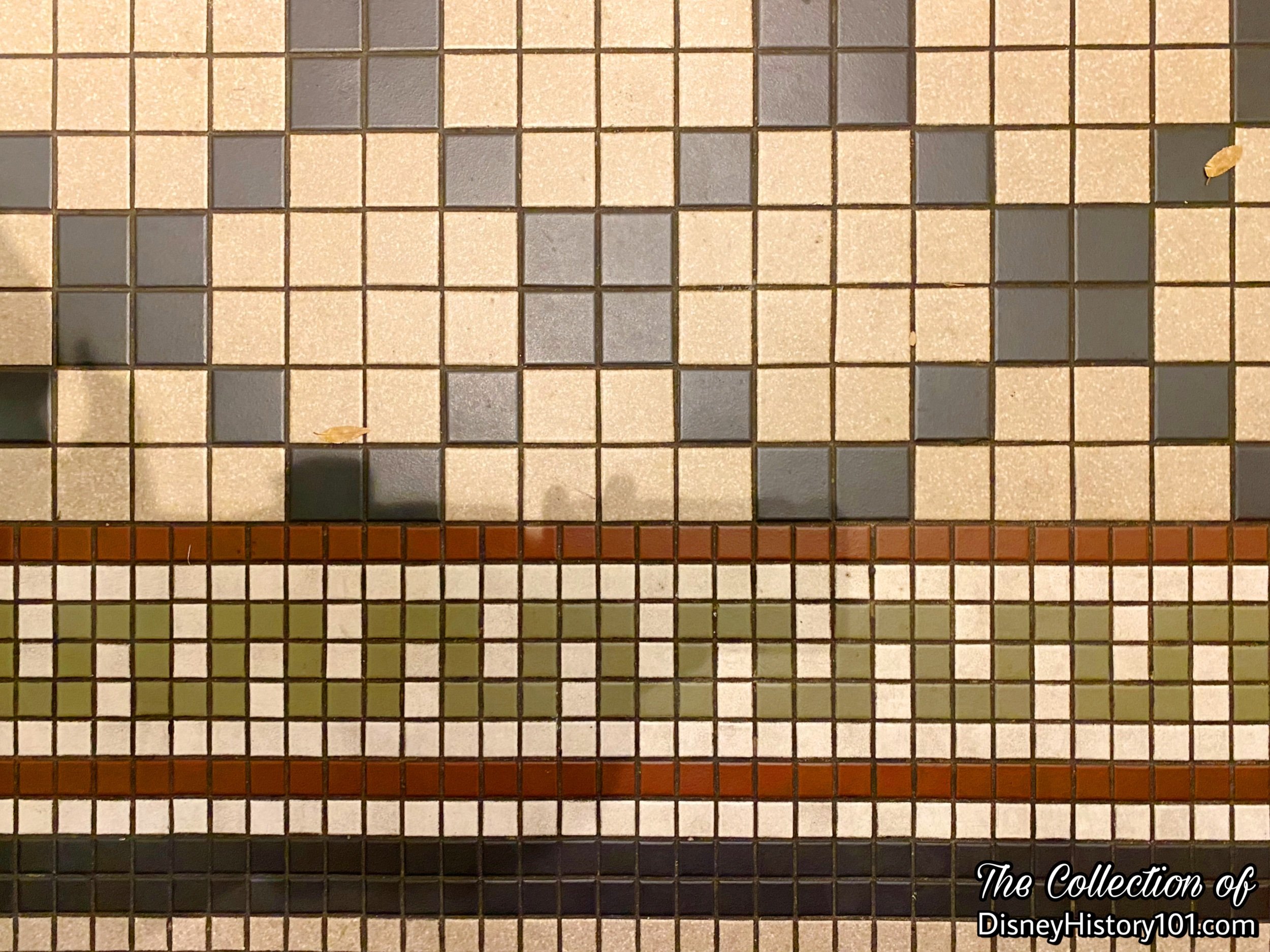
The Disney Gallery Floor Tile

